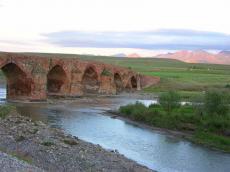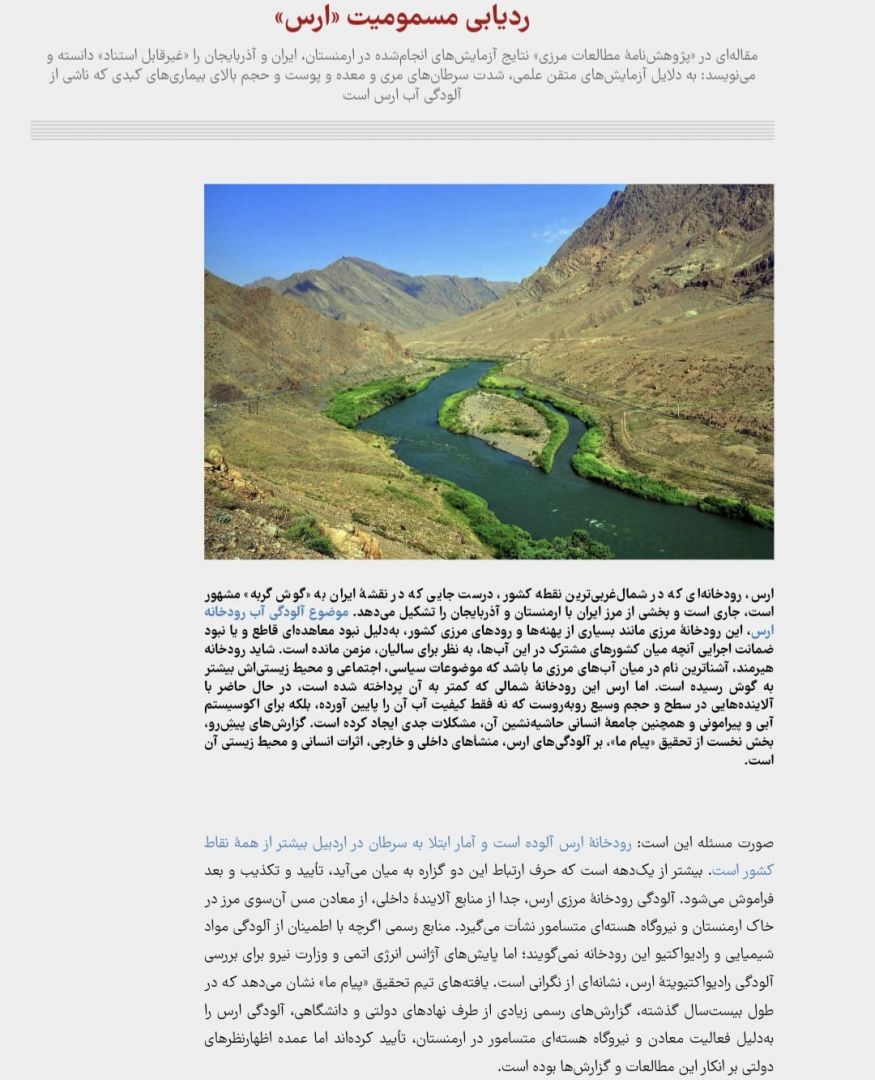|
|
TODAY.AZ / Your Corner
Iran also accuses Armenia on ecocide - population around Araz river may suffer from cancer
19 June 2023 [17:39] - TODAY.AZ
 By Azernews
By AzernewsIranian media recognized the Metsamor nuclear power plant as the cause of the pollution of the Araz River.
An article published in the Iranian newspaper "Payame ma" refers to the contamination of the Araz River with radioactive substances and heavy metals, Azernews reports, citing Iranian sources.

"In no way can it be denied that the Araz River is polluted with radioactive substances and heavy metals, which has led to an increase in cancer among the population," the article says.
According to the publication, the source of pollution is the Metsamor Nuclear Power Plant of Armenia.
Araz River, suffering from pollution, originates in the Arpachay region of Turkiye, passes through the border of Turkiye, Nakhchivan, Julfa and Armenia, and after crossing the border of Iran enters Azerbaijan, then enters the Kura River. This river flows into the Caspian Sea, having passed a path of more than 10 thousand kilometers. Conflicts arise from sewage that is discharged at the border points with Armenia, and when it reaches the reservoir of the Khudafarin dam, it pollutes the drinking water supply network and agricultural land of Mughan cities, towns and villages, such as Horadiz and Kordasht.
The use of outdated technologies and non-compliance with safety regulations during operation, as well as the Metsamor nuclear power plant located within the borders of Armenia and 16 km from Turkiye, poses a serious threat to all countries in the region. This power plant also poses a great danger to nature.
It should be noted that the Metsamor Nuclear Power Plant was built from 1969 to 1977 near the city of Metsamor. The nuclear power plant consists of two power units with VVER-440 type reactors (pressurized water power reactor with a power (electric) of 440 MW). Even when designing the station, the main difficulties were associated with its location in one of the most seismically dangerous points on Earth.
The first power unit of the NPP was put into operation in December 1976, the second - on January 5, 1980. In 1988, a powerful earthquake occurred in Armenia, the epicenter of which was the city of Spitak (in Soviet times it was called Leninakan). Tremors with a magnitude of more than 7 points claimed the lives of about 25 thousand people. However, the situation could lead to even more catastrophic consequences if an accident occurred at the Metsamor nuclear power plant, located just 84 km from Spitak.
Immediately after the earthquake, most of the plant's personnel fled the plant, and its trouble-free operation was threatened. Remembering the Chernobyl tragedy, the workers were afraid to return, and only the emergency transportation of personnel from other Soviet nuclear power plants made it possible to avoid an accident.
A month after the earthquake, two reactors of the Metsamor nuclear power plant were suspended. Only six and a half years later, in 1995, the Armenian authorities decided to start the second reactor. Today it generates 40% of the country's electricity. The first reactor, which had never been launched since 1989, was dismantled in 2017.
Despite the fact that, in 2014, the EU called the facility “a danger to the entire region” and was ready to allocate 200 million euros for the closure of Metsamor free of charge, but Armenia rejected the offer.
In addition, nuclear fuel for Metsamor is delivered from the Russian Federation, and all complex work at the station is carried out by Russian specialists under the guidance of Russian government agencies.
Meanwhile, Armenia intends to extend the life of the nuclear power plant until 2026, and in the future - until 2036.
According to an investigation by an Iranian publication, copper mines in Armenia also pollute the river. The failure of the Atomic Energy Organization and the Department of Energy to investigate radioactive contamination is a matter of concern.
Despite numerous government reports of contamination of the Araz River, Iranian officials deny the presence of uranium in the river.
As a result of water pollution among the population living in the border areas of the Araz River, cases of cancer of the esophagus, stomach, liver and skin have significantly increased. There are also reports of an increase in morbidity, in particular stomach cancer, among residents living along the Araz River. Along with Armenia, Iran is also the biggest polluter of the Araz River. The situation is exacerbated by the Sungun copper mine in Iran.
And according to mining experts, the Sungun copper mine is considered one of the largest copper mines in the world, containing 40% of the reserves discovered in Iran.
URL: http://www.today.az/news/yourcornenr/236234.html
 Print version
Print version
Connect with us. Get latest news and updates.
See Also
- 16 May 2024 [22:19]
Turkish Defense industry achieves self-sufficiency in military cable production - 16 May 2024 [21:50]
Russia and China expand cooperation in the energy sector - 07 January 2024 [20:40]
China plans to invest more than $11bn in development of Tibet in 2024 - 03 January 2024 [18:05]
Azerbaijani hero: One-man army destroying Armenian myth - 18 November 2023 [10:00]
Another group of IDPs return to Zabukh village [PHOTOS] - 05 November 2023 [10:28]
German FM is either lying or trying to cover up some dirty agenda - 05 November 2023 [10:00]
Azerbaijan and Germany enjoy huge potential for cooperation in many areas - 21 October 2023 [23:57]
Co-operation between Azerbaijan and Kazakhstan in various directions discussed - 21 October 2023 [22:31]
Regular meeting of Presidium of Bar Association took place at De Fendo Law Office - 21 October 2023 [21:32]
Armenia can become an important partner of Azerbaijan [PHOTOS]
Most Popular
 Macron received a slap in the face from the Vatican
Macron received a slap in the face from the Vatican
 Baku made Paris panic. What was Macron afraid of?
Baku made Paris panic. What was Macron afraid of?
 Who uses Greta Thunberg and how?
Who uses Greta Thunberg and how?
 Azerbaijan’s COP29 presidency sets precedent with focus on amplifying voices of vulnerable nations
Azerbaijan’s COP29 presidency sets precedent with focus on amplifying voices of vulnerable nations
 Minister Bayraktar emphasizes Turkiye's role in net zero emissions
Minister Bayraktar emphasizes Turkiye's role in net zero emissions
 Schwabe and his hackneyed whining
Schwabe and his hackneyed whining
 Pashinyan's allegation augurs Armenia's deviation from peace talks
Pashinyan's allegation augurs Armenia's deviation from peace talks
